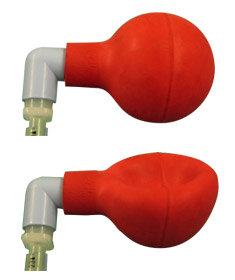The oesophageal intubation detector is a simple device that relies on the collapsibility of the oesophagus, and non-collapsibility of the trachea.
It is attached to the TT after placement and uses one of two methods for testing:
Testing for oesophageal intubation with this device is simple, useful and underused. It is not 100 % specific or sensitive, with more false positives than false negatives.

With the self-inflating bulb method, the bulb is initially deflated before attaching to the TT. If the TT is in the trachea, the bulb re-inflates (Fig 1, top).
If the TT is in the oesophagus, the bulb does not re-inflate (Fig 1, bottom), as the oesophagus collapses on application of ‘sub-atmospheric pressure’.
With the 50 ml syringe method an attempt is made to suck air from the TT.
This is not possible if the TT is in the oesophagus (which collapses), but is possible if it is in the trachea (which remains open).